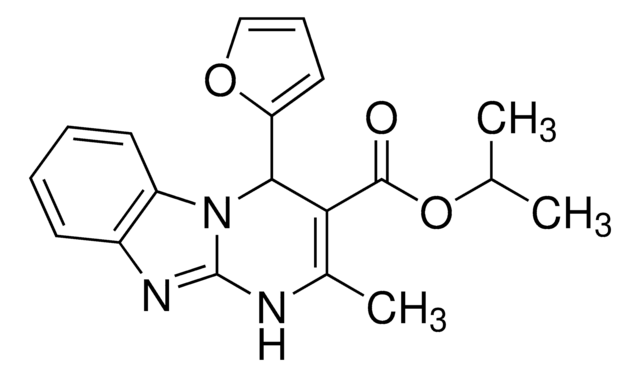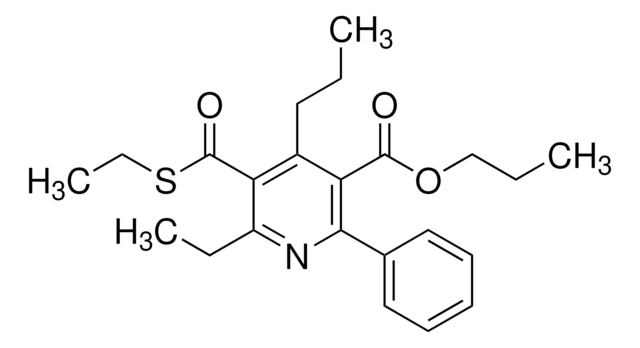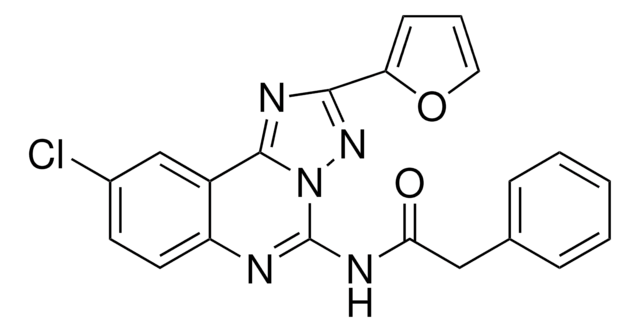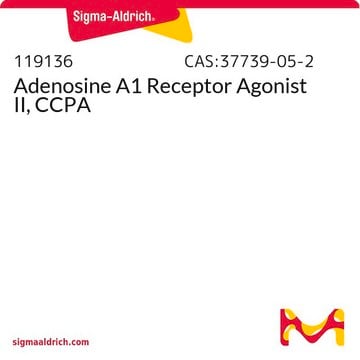推薦產品
形狀
solid
顏色
white
溶解度
DMSO: >10 mg/mL
ethanol: >10 mg/mL
H2O: insoluble
儲存溫度
−20°C
SMILES 字串
CCOC(=O)C1=C(C)NC(c2ccccc2)=C(C1C#Cc3ccccc3)C(=O)OCc4ccccc4
InChI
1S/C31H27NO4/c1-3-35-30(33)27-22(2)32-29(25-17-11-6-12-18-25)28(26(27)20-19-23-13-7-4-8-14-23)31(34)36-21-24-15-9-5-10-16-24/h4-18,26,32H,3,21H2,1-2H3
InChI 密鑰
SNVFDPHQAOXWJZ-UHFFFAOYSA-N
生化/生理作用
MRS 1191 is putative A3 adenosine receptor antagonist, highly selective for human A3 receptor vs human A1 receptor. MRS 1067, MRS 1191 and MRS 1220 were found to be competitive in saturation binding studies using the agonist radioligand [125I]AB-MECA at cloned human brain A3 receptors expressed in HEK-293 cells. Antagonism was demonstrated in functional assays consisting of agonist-induced inhibition of adenylate cyclase and the stimulation of binding of [35S]guanosine 5′-O-(3-thiotriphosphate) ([35S]GTP-gamma-S) to the associated G-proteins. Activation of the human A3 receptor in A3R-CHO results in markedly impaired cell cycle progression, suggesting an important role for this adenosine receptor subtype in cell cycle regulation and cell growth. Activation of adenosine A3 receptors by Cl-IBMECA (100 nM) increased the magnitude of theta-burst induced LTP (from 1.2+/-0.6% in the control solution to 25.5+/-0.8% in the presence of Cl-IBMECA) and attenuated LTD (from 30.0+/-5.5% decrease in the control solution to 13.6+/-6.6% decrease in the presence of Cl-IBMECA). The selective adenosine A3 receptor antagonist, MRS 1191 (5-10 μM), prevented the effects of Cl-IBMECA. These findings indicate a functional role for adenosine A3 receptors in the modulation of synaptic plasticity.
MRS 1191 is putative A3 adenosine receptor antagonist, highly selective for human A3 receptor vs human A1 receptor.
注意
Photosensitive
儲存類別代碼
11 - Combustible Solids
水污染物質分類(WGK)
WGK 3
閃點(°F)
Not applicable
閃點(°C)
Not applicable
個人防護裝備
Eyeshields, Gloves, type N95 (US)
從最近期的版本中選擇一個:
分析證明 (COA)
Lot/Batch Number
J L Jiang et al.
Journal of medicinal chemistry, 39(23), 4667-4675 (1996-11-08)
An approach to designing dihydropyridines that bind to adenosine receptors without binding to L-type calcium channels has been described. 1,4-Dihydropyridine derivatives substituted with beta-styryl or phenylethynyl groups at the 4-position and aryl groups at the 6-position were synthesized and found
K A Jacobson et al.
Neuropharmacology, 36(9), 1157-1165 (1997-11-19)
The effects of putative A3 adenosine receptor antagonists of three diverse chemical classes (the flavonoid MRS 1067, the 6-phenyl-1,4-dihydropyridines MRS 1097 and MRS 1191, and the triazoloquinazoline MRS 1220) were characterized in receptor binding and functional assays. MRS1067, MRS 1191
T V Dunwiddie et al.
The Journal of neuroscience : the official journal of the Society for Neuroscience, 17(2), 607-614 (1997-01-15)
The adenosine A3 receptor is expressed in brain, but the consequences of activation of this receptor on electrophysiological activity are unknown. We have characterized the actions of a selective adenosine A3 receptor agonist, 2-chloro-N6-(3-lodobenzyl)-adenosine-5'-N-methyluronamide (Cl-IB-MECA), and a selective A3 receptor
Marlon De Ita et al.
Life sciences, 145, 85-92 (2015-12-19)
Almost every eukaryotic cell releases ATP under certain conditions. The idea that ATP induces the release of ATP has been scantly investigated. We explored this possibility by assessing the rate of exogenous ATP breakdown (measured by phosphates production) by human
Laura Fontenas et al.
Cell reports, 27(1), 115-128 (2019-04-04)
During development, oligodendrocyte progenitor cells (OPCs) migrate extensively throughout the spinal cord. However, their migration is restricted at transition zones (TZs). At these specialized locations, unique glial cells in both zebrafish and mice play a role in preventing peripheral OPC
Active Filters
我們的科學家團隊在所有研究領域都有豐富的經驗,包括生命科學、材料科學、化學合成、色譜、分析等.
聯絡技術服務








